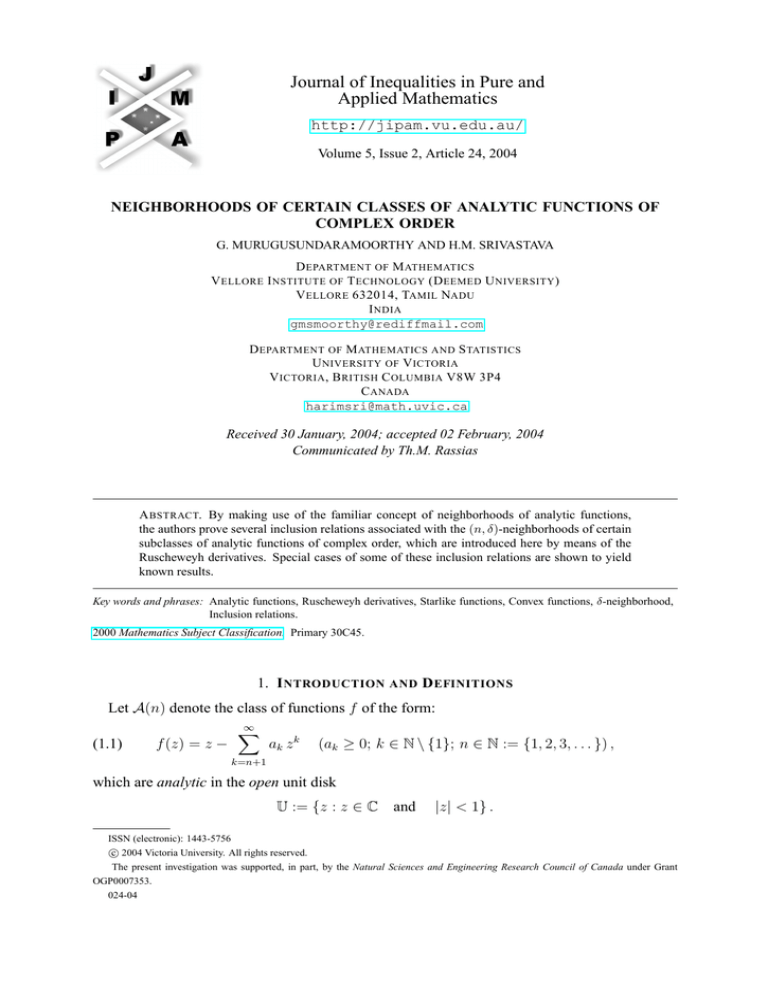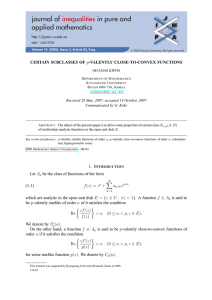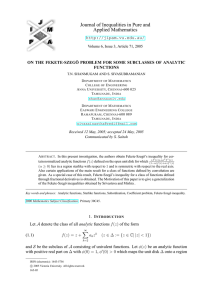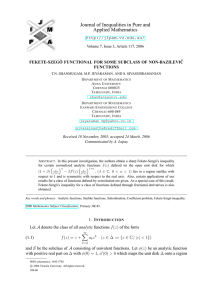
Journal of Inequalities in Pure and
Applied Mathematics
http://jipam.vu.edu.au/
Volume 5, Issue 2, Article 24, 2004
NEIGHBORHOODS OF CERTAIN CLASSES OF ANALYTIC FUNCTIONS OF
COMPLEX ORDER
G. MURUGUSUNDARAMOORTHY AND H.M. SRIVASTAVA
D EPARTMENT OF M ATHEMATICS
V ELLORE I NSTITUTE OF T ECHNOLOGY (D EEMED U NIVERSITY )
V ELLORE 632014, TAMIL NADU
I NDIA
gmsmoorthy@rediffmail.com
D EPARTMENT OF M ATHEMATICS AND S TATISTICS
U NIVERSITY OF V ICTORIA
V ICTORIA , B RITISH C OLUMBIA V8W 3P4
C ANADA
harimsri@math.uvic.ca
Received 30 January, 2004; accepted 02 February, 2004
Communicated by Th.M. Rassias
A BSTRACT. By making use of the familiar concept of neighborhoods of analytic functions,
the authors prove several inclusion relations associated with the (n, δ)-neighborhoods of certain
subclasses of analytic functions of complex order, which are introduced here by means of the
Ruscheweyh derivatives. Special cases of some of these inclusion relations are shown to yield
known results.
Key words and phrases: Analytic functions, Ruscheweyh derivatives, Starlike functions, Convex functions, δ-neighborhood,
Inclusion relations.
2000 Mathematics Subject Classification. Primary 30C45.
1. I NTRODUCTION AND D EFINITIONS
Let A(n) denote the class of functions f of the form:
(1.1)
f (z) = z −
∞
X
ak z k
(ak ≥ 0; k ∈ N \ {1}; n ∈ N := {1, 2, 3, . . . }) ,
k=n+1
which are analytic in the open unit disk
U := {z : z ∈ C
and
|z| < 1} .
ISSN (electronic): 1443-5756
c 2004 Victoria University. All rights reserved.
The present investigation was supported, in part, by the Natural Sciences and Engineering Research Council of Canada under Grant
OGP0007353.
024-04
2
G. M URUGUSUNDARAMOORTHY
AND
H.M. S RIVASTAVA
Following the works of Goodman [9] and Ruscheweyh [14], we define the (n, δ)-neighborhood
of a function f ∈ A(n) by (see also [2], [3], [4], and [16])
(
)
∞
∞
X
X
(1.2) Nn,δ (f ) := g ∈ A(n) : g(z) = z −
bk z k
and
k |ak − bk | ≤ δ .
k=n+1
k=n+1
In particular, for the identity function
e(z) = z,
(1.3)
we immediately have
(
(1.4)
Nn,δ (e) :=
g ∈ A(n) : g(z) = z −
∞
X
bk z k and
k=n+1
∞
X
)
k |bk | ≤ δ
.
k=n+1
The above concept of (n, δ)-neighborhoods was extended and applied recently to families
of analytically multivalent functions by Altintaş et al. [6] and to families of meromorphically
multivalent functions by Liu and Srivastava ([10] and [11]). The main object of the present paper
is to investigate the (n, δ)-neighborhoods of several subclasses of the class A(n) of normalized
analytic functions in U with negative and missing coefficients, which are introduced below by
making use of the Ruscheweyh derivatives.
First of all, we say that a function f ∈ A(n) is starlike of complex order γ (γ ∈ C \ {0}),
that is, f ∈ Sn∗ (γ), if it also satisfies the following inequality:
1 zf 0 (z)
(1.5)
R 1+
−1
> 0 (z ∈ U; γ ∈ C \ {0}) .
γ f (z)
Furthermore, a function f ∈ A(n) is said to be convex of complex order γ (γ ∈ C \ {0}) , that
is, f ∈ Cn (γ), if it also satisfies the following inequality:
1 zf 00 (z)
> 0 (z ∈ U; γ ∈ C \ {0}) .
(1.6)
R 1+
γ f 0 (z)
The classes Sn∗ (γ) and Cn (γ) stem essentially from the classes of starlike and convex functions of complex order, which were considered earlier by Nasr and Aouf [12] and Wiatrowski
[18], respectively (see also [5] and [7]).
Next, for the functions fj (j = 1, 2) given by
fj (z) = z +
(1.7)
∞
X
ak,j z k
(j = 1, 2) ,
k=2
let f1 ∗ f2 denote the Hadamard product (or convolution) of f1 and f2 , defined by
(f1 ∗ f2 ) (z) := z +
(1.8)
∞
X
ak,1 ak,2 z k =: (f2 ∗ f1 ) (z) .
k=2
Thus the Ruscheweyh derivative operator Dλ : A −→ A is defined for A := A (1) by
z
(1.9)
Dλ f (z) :=
∗ f (z)
(λ > −1; f ∈ A)
(1 − z)λ+1
or, equivalently, by
(1.10)
λ
D f (z) := z −
∞ X
λ+k−1
k=2
J. Inequal. Pure and Appl. Math., 5(2) Art. 24, 2004
k−1
ak z k
(λ > −1; f ∈ A)
http://jipam.vu.edu.au/
N EIGHBORHOODS OF C ERTAIN C LASSES OF A NALYTIC F UNCTIONS OF C OMPLEX O RDER
3
for a function f ∈ A of the form (1.1). Here, and in what follows, we make use of the following
standard notation:
κ
κ (κ − 1) · · · (κ − k + 1)
(1.11)
:=
(κ ∈ C; k ∈ N0 )
k
k!
for a binomial coefficient. In particular, we have
(n)
z z n−1 f (z)
n
(1.12)
D f (z) =
(n ∈ N0 := N ∪ {0}) .
n!
Finally, in terms of the Ruscheweyh derivative Dλ (λ > −1) defined by (1.9) or (1.10) above,
let Sn (γ, λ, β) denote the subclass of A(n) consisting of functions f which satisfy the following
inequality:
!
1 z Dλ f (z)0
(1.13)
−1 <β
λ
γ
D f (z)
(z ∈ U; γ ∈ C \ {0}; λ > −1; 0 < β ≤ 1) .
Also let Rn (γ, λ, β; µ) denote the subclass of A (n) consisting of functions f which satisfy the
following inequality:
1
0
Dλ f (z)
λ
<β
(1.14)
(1
−
µ)
+
µ
D
f
(z)
−
1
γ
z
(z ∈ U; γ ∈ C \ {0}; λ > −1; 0 < β ≤ 1; 0 ≤ µ ≤ 1) .
Various further subclasses of the classes Sn (γ, λ, β) and Rn (γ, λ, β; µ) with γ = 1 were
studied in many earlier works (cf., e.g., [8] and [17]; see also the references cited in these
earlier works). Clearly, in the case of (for example) the class Sn (γ, λ, β), we have
Sn (γ, 0, 1) ⊂ Sn∗ (γ) and
(1.15)
Sn (γ, 1, 1) ⊂ Cn (γ)
(n ∈ N; γ ∈ C \ {0}) .
2. I NCLUSION R ELATIONS I NVOLVING Nn,δ (e)
In our investigation of the inclusion relations involving Nn,δ (e), we shall require Lemma 1
and Lemma 2 below.
Lemma 1. Let the function f ∈ A(n) be defined by (1.1). Then f is in the class Sn (γ, λ, β) if
and only if
∞ X
λ+k−1
(2.1)
(β|γ| + k − 1) ak ≤ β|γ|.
k
−
1
k=n+1
Proof. We first suppose that f ∈ Sn (γ, λ, β). Then, by appealing to the condition (1.13), we
readily obtain
!
0
z Dλ f (z)
(2.2)
R
− 1 > −β|γ| (z ∈ U)
Dλ f (z)
or, equivalently,
(2.3)
λ+k−1
k
(k − 1)ak z
−
k−1
k=n+1
R
> −β|γ|
∞
P
λ+k−1
z−
ak z k
k−1
k=n+1
∞
P
J. Inequal. Pure and Appl. Math., 5(2) Art. 24, 2004
(z ∈ U) ,
http://jipam.vu.edu.au/
4
G. M URUGUSUNDARAMOORTHY
AND
H.M. S RIVASTAVA
where we have made use of (1.10) and the definition (1.1). We now choose values of z on the
real axis and let z → 1− through real values. Then the inequality (2.3) immediately yields the
desired condition (2.1). Conversely, by applying the hypothesis (2.1) and letting |z| = 1, we
find that
∞
P
λ+k−1
k
(k
−
1)a
z
k
z Dλ f (z) 0
k
−
1
k=n+1
−
1
=
∞
P
Dλ f (z)
λ+k−1
k
z−
ak z k−1
k=n+1
∞
P
λ+k−1
β|γ| 1 −
ak
k−1
k=n+1
≤
∞
P
λ+k−1
1−
ak
k−1
k=n+1
(2.4)
≤ β|γ|.
Hence, by the maximum modulus theorem, we have
f ∈ Sn (γ, λ, β),
which evidently completes the proof of Lemma 1.
Similarly, we can prove the following result.
Lemma 2. Let the function f ∈ A (n) be defined by (1.1). Then f is in the class R(γ, λ, β; µ)
if and only if
∞ X
λ+k−1
(2.5)
[µ (k − 1) + 1] ak ≤ β|γ|.
k
−
1
k=n+1
Remark 1. A special case of Lemma 1 when
n = 1,
γ = 1,
and
β =1−α
(0 ≤ α < 1)
was given earlier by Ahuja [1]. Furthermore, if in Lemma 1 with
n = 1,
γ = 1,
and
β =1−α
(0 ≤ α < 1) ,
we set λ = 0 and λ = 1, we shall obtain the familiar results of Silverman [15].
Our first inclusion relation involving Nn,δ (e) is given by Theorem 1 below.
Theorem 1. If
(2.6)
δ :=
(n + 1)β|γ|
λ+n
(β|γ| + n)
n
(|γ| < 1),
then
(2.7)
Sn (γ, λ, β) ⊂ Nn,δ (e).
Proof. For a function f ∈ Sn (γ, λ, β) of the form (1.1), Lemma 1 immediately yields
∞
λ+n X
(β |γ| + n)
ak ≤ β|γ|,
n
k=n+1
J. Inequal. Pure and Appl. Math., 5(2) Art. 24, 2004
http://jipam.vu.edu.au/
N EIGHBORHOODS OF C ERTAIN C LASSES OF A NALYTIC F UNCTIONS OF C OMPLEX O RDER
5
so that
(2.8)
∞
X
ak ≤
k=n+1
β|γ|
.
λ+n
(β |γ| + n)
n
On the other hand, we also find from (2.1) and (2.8) that
∞
∞
λ+n X
λ+n X
ak
kak ≤ β|γ| + (1 − β|γ|)
n
n
k=n+1
k=n+1
λ+n
β|γ|
≤ β|γ| + (1 − β|γ|)
λ+n
n
(β |γ| + n)
n
(n + 1)β|γ|
≤
(|γ| < 1),
β|γ| + n
that is,
∞
X
(n + 1)β|γ|
:= δ,
(2.9)
kak ≤
λ+n
k=n+1
(β |γ| + n)
n
which, in view of the definition (1.4), proves Theorem 1.
By similarly applying Lemma 2 instead of Lemma 1, we now prove Theorem 2 below.
Theorem 2. If
(2.10)
δ :=
(n + 1) β |γ|
,
λ+n
(µn + 1)
n
then
(2.11)
Rn (γ, λ, β; µ) ⊂ Nn,δ (e).
Proof. Suppose that a function f ∈ R (γ, λ, β; µ) is of the form (1.1). Then we find from the
assertion (2.5) of Lemma 2 that
∞
X
λ+n
(µn + 1)
ak ≤ β |γ| ,
n
k=n+1
which yields the following coefficient inequality:
∞
X
β |γ|
.
(2.12)
ak ≤
λ+n
k=n+1
(µn + 1)
n
Making use of (2.5) in conjunction with (2.12), we also have
∞
∞
λ+n X
λ+n X
µ
kak ≤ β |γ| + (µ − 1)
ak
n
n
k=n+1
k=n+1
λ+n
β |γ|
,
(2.13)
≤ β |γ| + (µ − 1)
λ+n
n
(µn + 1)
n
J. Inequal. Pure and Appl. Math., 5(2) Art. 24, 2004
http://jipam.vu.edu.au/
6
G. M URUGUSUNDARAMOORTHY
AND
H.M. S RIVASTAVA
that is,
∞
X
kak ≤
k=n+1
(n + 1) β |γ|
=: δ,
λ+n
(µn + 1)
n
which, in light of the definition (1.4), completes the proof of Theorem 2.
Remark 2. By suitably specializing the various parameters involved in Theorem 1 and Theorem 2, we can derive the corresponding inclusion relations for many relatively more familiar
function classes (see also Equation (1.15) and Remark 1 above).
(α)
(α)
3. N EIGHBORHOODS FOR THE C LASSES Sn (γ, λ, β) AND Rn (γ, λ, β; µ)
In this section we determine the neighborhood for each of the classes
Sn(α) (γ, λ, β) and R(α)
n (γ, λ, β; µ),
(α)
which we define as follows. A function f ∈ A(n) is said to be in the class Sn (γ, λ, β) if there
exists a function g ∈ Sn (γ, λ, β) such that
f (z)
< 1 − α (z ∈ U; 0 ≤ α < 1) .
(3.1)
−
1
g(z)
(α)
Analogously, a function f ∈ A(n) is said to be in the class Rn (γ, λ, β; µ) if there exists a
function g ∈ Rn (γ, λ, β; µ) such that the inequality (3.1) holds true.
Theorem 3. If g ∈ Sn (γ, λ, β) and
(3.2)
λ+n
(β |γ| + n) δ
n
,
α=1−
λ+n
(n + 1) (β |γ| + n)
− β |γ|
n
then
Nn,δ (g) ⊂ Sn(α) (γ, λ, β).
(3.3)
Proof. Suppose that f ∈ Nn,δ (g). We then find from the definition (1.2) that
∞
X
(3.4)
k |ak − bk | ≤ δ,
k=n+1
which readily implies the coefficient inequality:
(3.5)
∞
X
|ak − bk | ≤
k=n+1
δ
n+1
(n ∈ N).
Next, since g ∈ Sn (γ, λ, β), we have [cf. Equation (2.8)]
(3.6)
∞
X
k=n+1
J. Inequal. Pure and Appl. Math., 5(2) Art. 24, 2004
bk ≤
β|γ|
,
λ+n
(β |γ| + n)
n
http://jipam.vu.edu.au/
N EIGHBORHOODS OF C ERTAIN C LASSES OF A NALYTIC F UNCTIONS OF C OMPLEX O RDER
7
so that
∞
P
f (z)
<
−
1
g(z)
|ak − bk |
k=n+1
1−
∞
P
bk
k=n+1
(3.7)
λ+n
(β |γ| + n)
δ
n
≤
·
λ+n
n+1
(β |γ| + n)
− β |γ|
n
= 1 − α,
(α)
provided that α is given precisely by (3.2). Thus, by definition, f ∈ Sn (γ, λ, β) for α given
by (3.2). This evidently completes our proof of Theorem 3.
Our proof of Theorem 4 below is much akin to that of Theorem 3.
Theorem 4. If g ∈ Rn (γ, λ, β; µ) and
(3.8)
λ+n
(µn + 1) δ
n
,
α=1−
λ+n
(n + 1) (µn + 1)
− β |γ|
n
then
(3.9)
Nn,δ (g) ⊂ R(α)
n (γ, λ, β; µ).
Remark 3. Just as we indicated already in Section 1 and Remark 2, Theorem 3 and Theorem 4
can readily be specialized to deduce the corresponding neighborhood results for many simpler
function classes.
R EFERENCES
[1] O.P. AHUJA, Hadamard products of analytic functions defined by Ruscheweyh derivatives, in Current Topics in Analytic Function Theory, H.M. Srivastava and S. Owa (Eds.), pp. 13–28, World
Scientific Publishing Company, Singapore, New Jersey, London and Hong Kong, 1992.
[2] O.P. AHUJA AND M. NUNOKAWA, Neighborhoods of analytic functions defined by Ruscheweyh
derivatives, Math. Japon., 51 (2003), 487–492.
[3] O. ALTINTAŞ AND S. OWA, Neighborhoods of certain analytic functions with negative coefficients, Internat. J. Math. and Math. Sci., 19 (1996), 797–800.
[4] O. ALTINTAŞ, Ö. ÖZKAN AND H.M. SRIVASTAVA, Neighborhoods of a class of analytic functions with negative coefficients, Appl. Math. Lett., 13(3) (2000), 63–67.
[5] O. ALTINTAŞ, Ö. ÖZKAN AND H.M. SRIVASTAVA, Majorization by starlike functions of complex order, Complex Variables Theory Appl., 46 (2001), 207–218.
[6] O. ALTINTAŞ, Ö. ÖZKAN AND H.M. SRIVASTAVA, Neighborhoods of a certain family of multivalent functions with negative coefficients, Comput. Math. Appl., 47 (2004) (to appear).
[7] O. ALTINTAŞ AND H.M. SRIVASTAVA, Some majorization problems associated with p-valently
starlike and convex functions of complex order, East Asian Math. J., 17 (2001), 175–183.
[8] P.L. DUREN, Univalent Functions, A Series of Comprehensive Studies in Mathematics, Vol. 259,
Springer-Verlag, New York, Berlin, Heidelberg, and Tokyo, 1983.
J. Inequal. Pure and Appl. Math., 5(2) Art. 24, 2004
http://jipam.vu.edu.au/
8
G. M URUGUSUNDARAMOORTHY
AND
H.M. S RIVASTAVA
[9] A.W. GOODMAN, Univalent functions and nonanalytic curves, Proc. Amer. Math. Soc., 8 (1957),
598–601.
[10] J.-L. LIU AND H.M. SRIVASTAVA, Classes of meromorphically multivalent functions associated
with the generalized hypergeometric function, Math. Comput. Modelling, 39 (2004), 21–34.
[11] J.-L. LIU AND H.M. SRIVASTAVA, Subclasses of meromorphically multivalent functions associated with a certain linear operator, Math. Comput. Modelling, 39 (2004), 35–44.
[12] M.A. NASR AND M.K. AOUF, Starlike function of complex order, J. Natur. Sci. Math., 25 (1985),
1–12.
[13] S. RUSCHEWEYH, New criteria for univalent functions, Proc. Amer. Math. Soc., 49 (1975), 109–
115.
[14] S. RUSCHEWEYH, Neighborhoods of univalent functions, Proc. Amer. Math. Soc., 81 (1981),
521–527.
[15] H. SILVERMAN, Univalent functions with negative coefficients, Proc. Amer. Math. Soc., 51
(1975), 109–116.
[16] H. SILVERMAN, Neighborhoods of classes of analytic functions, Far East J. Math. Sci., 3 (1995),
165–169.
[17] H.M. SRIVASTAVA AND S. OWA (Eds.), Current Topics in Analytic Function Theory, World
Scientific Publishing Company, Singapore, New Jersey, London and Hong Kong, 1992.
[18] P. WIATROWSKI, On the coefficients of some family of holomorphic functions, Zeszyty Nauk.
Uniw. Łódz Nauk. Mat.-Przyrod. (2), 39 (1970), 75–85.
J. Inequal. Pure and Appl. Math., 5(2) Art. 24, 2004
http://jipam.vu.edu.au/












